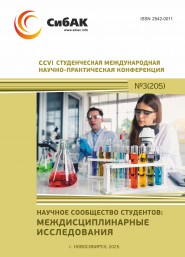Статья опубликована в рамках: CCVI Международной научно-практической конференции «Научное сообщество студентов: МЕЖДИСЦИПЛИНАРНЫЕ ИССЛЕДОВАНИЯ» (Россия, г. Новосибирск, 13 февраля 2025 г.)
Наука: Педагогика
Скачать книгу(-и): Сборник статей конференции
дипломов
THE LANGUAGE PORTFOLIO AS A MEANS OF DEVELOPING INTERCULTURAL COMMUNICATIVE COMPETENCE
ABSTRACT
In the context of modern language education, fostering intercultural communicative competence (ICC) has become a central objective. The Language Portfolio, initially introduced within the framework of the Common European Framework of Reference for Languages (CEFR), serves as an effective tool for developing both linguistic proficiency and cultural awareness. This article explores the role of the Language Portfolio in enhancing ICC, emphasizing its impact on self-reflection, goal-setting, and intercultural adaptability. Key components of the Portfolio, such as the Language Passport, Language Biography, and Dossier, encourage students to document their linguistic progress while actively engaging with different cultural perspectives. The paper also discusses the challenges of implementing the Language Portfolio in educational settings and presents insights from its adaptation in Kazakh Ablai Khan University of International Relations and World Languages. Ultimately, this study highlights the potential of the Language Portfolio to transform language learning into a dynamic and culturally enriching experience.
Keywords: language portfolio, intercultural communicative competence, CEFR, foreign language education, self-reflection, communicative competence.
INTRODUCTION
In an increasingly globalized world, language education extends beyond grammar and vocabulary acquisition—it fosters an ability to communicate across cultures. This broader objective aligns with intercultural communicative competence (ICC), a concept that emphasizes both linguistic proficiency and cultural adaptability [1]. One educational tool that supports ICC development is the Language Portfolio, introduced within the framework of the Common European Framework of Reference for Languages (CEFR). Originally designed as a tool for documenting language proficiency, the Language Portfolio has evolved into a reflective instrument that helps learners track their linguistic progress while engaging with diverse cultural perspectives. Its emphasis on self-assessment, intercultural awareness, and autonomy makes it an essential component of modern foreign language education [3].
INTERCULTURAL COMMUNICATIVE COMPETENCE IN LANGUAGE LEARNING
The foundation of ICC lies in communicative competence, a concept first introduced by Dell Hymes as an alternative to Chomsky’s purely structural approach to language learning. Hymes argued that communication involves more than grammatical accuracy—it requires social and cultural awareness [2]. Later, Michael Byram expanded this idea by identifying key components of ICC: 1. Attitudes – Openness and curiosity toward other cultures. 2. Knowledge – Understanding both one’s own culture and that of others. 3. Skills of interpreting and relating – The ability to compare cultural phenomena critically. 4. Skills of discovery and interaction – The ability to adapt and learn from intercultural encounters.
Without ICC, even highly proficient speakers may struggle to navigate real-world communication, where cultural context significantly influences meaning [5]. This shift in language education from purely linguistic goals to communicative and cultural objectives is one of the key reasons for incorporating tools like the Language Portfolio.
THE ROLE OF THE LANGUAGE PORTFOLIO IN DEVELOPING ICC
The Language Portfolio consists of three key components: The Language Passport – A record of language qualifications and self-assessed proficiency. The Language Biography – A reflective section where learners document their intercultural experiences. The Dossier – A collection of work that demonstrates language and intercultural progress.
Unlike traditional assessment methods, the Language Portfolio encourages learners to actively engage in reflection about their language-learning journey. Instead of focusing solely on test scores, students analyze their personal experiences, challenges, and cultural insights [4 p. 27].
At Kazakh Ablai Khan University of International Relations and World Languages, a domestic version of the Language Portfolio has been developed based on the principles of the ELP and CEFR. This model fosters independent learning, allowing students to monitor their progress, assess their linguistic competencies, and engage in self-directed improvement. The key elements of the Kazakhstani Language Portfolio include:
Language Passport – A summary of the student’s linguistic and intercultural experiences, including studied languages, exam results, and CEFR-based self-assessment. Language Biography – A reflection tool for documenting learning experiences, setting personal goals, and strategizing improvements in listening, speaking, reading, and writing. Dossier – A compilation of projects, certificates, and written work that showcase progress [6 p. 149-150].
This structured approach motivates students and encourages responsibility in their learning, promoting systematic development in a multilingual environment. A self-assessment sheet included in the portfolio further enables students to identify their priorities and monitor their achievements over time.
CONCLUSION
The Language Portfolio is a powerful tool in modern language education, fostering both linguistic proficiency and intercultural competence. By encouraging students to reflect on their learning journey, set goals, and document their progress, the Portfolio transforms language learning into an active and engaging process.
References:
- Byram M. Teaching and Assessing Intercultural Communicative Competence. — Clevedon: Multilingual Matters, 1997. — 124 p.
- Hymes D. On Communicative Competence // Sociolinguistics / Ed. by J. Pride, J. Holmes. — Harmondsworth: Penguin Books, 1972. — P. 269-285.
- Little D. The European Language Portfolio: Where Pedagogy and Assessment Meet. — Strasbourg: Council of Europe, 2009.
- Little D., Perclova R. The European Language Portfolio: A Guide for Teachers and Teacher Trainers. — Strasbourg: Council of Europe, 2001. — 64 p.
- Kunanbayeva S.S. The Modernization of Foreign Language Education: The Linguo-Cultural-Communicative Approach. — 2nd ed. — London: Hertfordshire Press, 2013. — 293 p.
- Savankova M.V., Dobayev K.D. The Role of Portfolio in Promoting Multilingual Education in the Republic of Kazakhstan // Proceedings of SOCIOINT 2018 – 5th International Conference on Education, Social Sciences and Humanities, 2-4 July 2018. — Dubai, UAE.
дипломов


Оставить комментарий